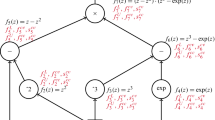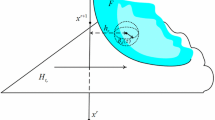Abstract
This paper reviews some of the most intriguing results and questions related to Lagrangean relaxation. It recalls essential properties of the Lagrangean relaxation and of the Lagrangean function, describes several algorithms to solve the Lagrangean dual problem, and considers Lagrangean heuristics, ad-hoc or generic, because these are an integral part of any Lagrangean approximation scheme. It discusses schemes that can potentially improve the Lagrangean relaxation bound, and describes several applications of Lagrangean relaxation, which demonstrate the flexibility of the approach, and permit either the computation of strong bounds on the optimal value of the MIP problem, or the use of a Lagrangean heuristic, possibly followed by an iterative improvement heuristic. The paper also analyzes several interesting questions, such as why it is sometimes possible to get a strong bound by solving simple problems, and why an a-priori weaker relaxation can sometimes be “just as good” as an a-priori stronger one.
Similar content being viewed by others
References
Andalaft N., Andalaft P., Guignard M., Magendzo A., Wainer A., Weintraub A. (2003). A problem of forest harvesting and road building solved through model strengthening and Lagrangean relaxation.Operations Research 51, 613–628.
Bahiense L., Maculan N. and Sagastizábal C. (2002). The volume algorithm revisited: relation with bundle methods.Mathematical Programming 94, 41–70.
Balas E. and Christofides N. (1981). A restricted Lagrangean approach to the traveling salesman problem.Mathematical Programming 21, 19–46.
Barahona F. and Anbil R. (2000). The volume algorithm: producing primal solutions with a subgradient method.Mathematical Programming 87, 385–399.
Barnhart C., Johnson E.L., Nemhauser G.L., Savelsbergh M.W.P. and Vance P. (1998). Branch-and-price: column generation for solving huge integer programs.Operations Research 46, 316–329.
Beasley J.E. (1993). Lagrangean relaxation. In: Reeves C.R. (ed.),Modern heuristic techniques for combinatorial problems. Blackwell Scientific Publications, 243–303.
Bilde and Krarup (1977). Sharp lower bounds and efficient algorithms for the simple plant location problem.Annals of Discrete Mathematics 1, 79–97. (Also a 1967 report in Danish)
Bowman E.H. (1956). Production scheduling by the transportation method of linear programming.Operations Research 4, 100–103.
Camerini P.M., Fratta L. and Maffoli F. (1975). On improving relaxation methods by modified gradient techniques.Mathematical Programming Study 3, 26–34.
Chajakis E., Guignard M. and Ryu C. (1994). Lagrangean bounds and heuristics for integrated resource planning in forestry. Proceedings of Symposium on Systems Analysis and Forest Management Problems, Valdivia, Chile, 1993, 350–363.
Chajakis E., Guignard M., Yan H. and Zhu S. (1996). The Lazy Lagrangean Heuristic, Optimization Days, Montreal, 1996.
Chen B. and Guignard M. (1991).LD = LDA for CPLP, Department of Decision Sciences Report 91-12-03, Wharton School, University of Pennsylvania.
Chen B. and Guignard M. (1998). Polyhedral analysis and decompositions for capacitated plant location-type problems.Discrete Applied Mathematics 82, 79–91.
Cheney E.W. and Goldstein A.A. (1959). Newton’s method for convex programming and Tchebicheff approximations.Numerische Mathematik 1, 253–268.
Contesse L. and Guignard M. (1995). A Proximal Augmented Lagrangean Relaxation for Linear and Nonlinear Integer Programming, Report 95-03-06, Operations and Information Management Department, University of Pennsylvania.
Contesse L. and Guignard M. (2002). An Augmented Lagrangean relaxation for integer programming with application to nonlinear capacitated facility location. Part I: theory and algorithm, Research Report, Operations and Information Management Department, University of Pennsylvania.
Contesse L., Guignard M. and Ahn S. (2002). Augmented Lagrangean relaxation for integer programming with application to nonlinear capacitated facility location. Part II, Algorithm and Computational Results, Research Report, Operations and Information Management Department, University of Pennsylvania.
Dantzig G. B. and Wolfe P. (1960). The decomposition principle for linear programs.Operations Research 8, 101–111.
Dantzig G. B. and Wolfe P. (1961). The decomposition algorithm for linear programs.Econometrica 29, 767–778.
de Matta R. (1989). On solving production scheduling problems with changeover costs using Lagrangean relaxation, Doctoral dissertation, Department of Decision Sciences, University of Pennsylvania.
de Matta R. and Guignard M. (1994). Dynamic production scheduling for a process industry.Operations Research 42, 492–503.
Desrosiers J., Soumis F. and Desrochers M. (1984). Routing with time windows by column generation.Networks 14, 545–565.
Desrosiers J., Sauvé M. and Soumis F. (1988). Lagrangian relaxation methods for solving the minimum fleet size multiple traveling salesman problem with time windows.Management Science 34, 1005–1022.
du Merle O., Goffin J.-L. and Vial J.-Ph. (1998). On improvements to the analytic center cutting plane method.Computational Optimization and Applications 11, 37–52.
du Merle O., Villeneuve D., Desrosiers J. and Hansen P. (1999). Stabilized column generation.Discrete Mathematics 94, 229–237.
Escudero L., Guignard M. and Malik K. (1994). A Lagrangean Relax-and-Cut approach for the sequential ordering problem with precedence relationships.Annals of Operations Research 50, 219–237.
Erlenkotter D. (1978). A dual-based procedure for uncapacitated facility location.Operations Research 26, 992–1009.
Everett III H. (1963). Generalized Lagrange multiplier method for solving problems of optimum allocation of resources.Operations Research 11, 399–417.
Fisher M.L. (1981). The Lagrangian relaxation method for solving integer programming problems.Management Science 27, 1–18.
Fisher M.L. (1985). An applications oriented guide to Lagrangian relaxation.Interfaces 15, 10–21.
Fisher M.L. and Hochbaum D.S. (1980). Database location in a computer network.Journal of the ACM 27, 718–735.
Fisher M.L., Jaikumar R. and van Wassenhove L.N. (1986). A multiplier adjustment method for the generalized assignment problem.Management Science 32, 1095–1103.
Fisher M.L. and Kedia P. (1990). Optimal Solution of Set Covering/Partitioning Problems Using Dual Heuristics.Management Science 39, 67–88.
Fisher M.L., Northup W.D. and Shapiro J.F. (1975). Using duality to solve discrete optimization problems: theory and computational experience.Mathematical Programming Study 3, 56–94.
Geoffrion A.M. (1974). Lagrangean relaxation for integer programming.Mathematical Programming Study 2, 82–114.
Geoffrion A.M. and McBride R. (1978). Lagrangean relaxation applied to capacitated facility location problems.AIIE Transactions 10, 40–47.
Glover F. and Klingman D. (1988). Layering strategies for creating exploitable structure in linear and integer programs.Mathematical Programming 40, 165–182.
Guignard M. (1989). General aggregation schemes in Lagrangean decomposition: theory and potential applications, Working paper 89-12-07, Department of Decision Sciences, University of Pennsylvania.
Guignard M. (1993). Solving makespan minimization problems with lagrangean decomposition.Discrete Applied Mathematics 42, 17–29.
Guignard M. (1994). Primal relaxation in integer programming. VII CLAIO Meeting, Santiago, Chile, 1994, and Operations and Information Management Department Working Paper 94-02-01, University of Pennsylvania, 1994.
Guignard M. (1998). Efficient cuts in Lagrangean Relax-and-Cut schemes.European Journal of Operational Research 105, 216–223.
Guignard M., Chajakis E. and Ryu C. (1994). Harvest scheduling and transportation planning in forest management, VII CLAIO Meeting, Santiago, Chile, July 1994 and Working paper 94-02-02, Operations and Information Management Department, University of Pennsylvania.
Guignard M. and Kim S. (1987). Lagrangean decomposition: a model yielding stronger Lagrangean bounds.Mathematical Programming 39, 215–228.
Guignard M. and Rosenwein M.B. (1989). An application-oriented guide for designing Lagrangian dual ascent algorithms.European Journal of Operational Research 43, 197–205.
Guignard M. and Rosenwein M.B. (1989). An improved dual-based algorithm for the generalized assignment problem.Operations Research 37, 658–663.
Guignard M., Ryu Ch. and Spielberg K. (1998). Model tightening for integrated timber harvest and transportation planning.European Journal of Operational Research 111, 448–460.
Guignard M., Ryu Ch., Qian H. and Dowlath L. (2002). Multi-item capacitated lot-sizing problem (MCLP). IV ALIO/EURO Workshop on Applied Combinatorial Optimization, 2002, http://www-di.inf.puc-rio.br/~celso/artigos/pucon.ps.
Guignard M. and Yan H. (1993). Structural decomposition methods for dynamic multi-hydropower plant optimization, Research Report 93-12-01, Operations and Information Management Department, University of Pennsylvania.
Guignard, M. and Zhu S. (1994). A hybrid algorithm for solving Lagrangean duals in mixed-integer programming, Proceedings of the VI CLAIO, Santiago, Chile, 1994, 399–410.
Held M. and Karp R.M. (1970). The traveling salesman problem and minimum spanning trees.Operations Research 18, 1138–1162.
Held M. and Karp R.M. (1971). The traveling salesman problem and minimum spanning trees: part II.Mathematical Programming 1, 6–25.
Held M., Wolfe P. and Crowder H. (1974). Validation of subgradient optimization.Mathematical Programming 6, 62–88.
Hiriart-Urruty J.-B. and Lemaréchal C. (1993). Convex analysis and minimization algorithms II.Grundlehren der mathematischen Wissenschaften, 306. Springer.
Jörnsten K. and Näsberg M. (1986). A new Lagrangian relaxation approach to the generalized assignment problem.European Journal of Operational Research 27, 313–323.
Kelley J.E. (1960). The cutting-plane method for solving convex programs.Journal of the SIAM 8, 703–712.
Lemaréchal C. (1974). An algorithm for minimizing convex functions, Proceedings IFIP’74 Congress. North Holland, 552–556.
Lemaréchal C. (1989). Nondifferentiable optimization. In: Nemhauser G.L., Rinnoy Khan H.H.G. and Todd M.J. (eds.),Handbooks in Operations Research and Management Science, 1: Optimization. North Holland.
Lemaréchal C., (2001). Lagrangian relaxation. In: Jünger M. and Naddef D. (eds.),Computational Combinatorial Optimization. Springer Verlag, 115–160.
Lemaréchal C. and Zowe J. (1994). A condensed introduction to bundle methods in nonsmooth optimization. In: Spedicato E. (ed.),Algorithms for Continuous Optimization. Kluwer Academic Publishers, 357–382.
Lee H. and Guignard M. (1996). A hybrid bounding procedure for the workload allocation problem on parallel unrelated machines with setups.Journal of the Operational Research Society 47, 1247–1261.
Lucena A. (1982). Steiner problem in graphs, Lagrangean relaxation and cutting planes.COAL Bulletin 21, 2–8.
Näsberg M., Jörnsten K.O. and Smeds P.A. (1985). Variable Splitting — A new Lagrangean relaxation approach to some mathematical programming problems, Report LITH-MAT-R-85-04, Linkoping University, 1985.
Poljak B.T. (1978). Subgradient methods: a survey of soviet research. In: Lemaréchal C. and Mifflin R. (eds.),Nonsmooth Optimization, IIASA Proceeding Series, Volume 3. Pergamon Press.
Reinoso H. and Maculan N. (1992). Lagrangean decomposition in integer linear programming: a new scheme.INFOR 30, 1–5
Ribeiro C. and Minoux M. (1986). Solving hard constrained shortest path problems by Lagrangean relaxation and branch-and-bound algorithms.Mathematics of Operations Research 53, 303–316.
Ross G.T. and Soland R.M. (1975). A branch-and-bound algorithm for the generalized assignment problem.Mathematical Programming 8, 91–103.
Ryan D.M. and Foster B.A. (1981). An Integer Programming Approach to Scheduling. In: Wren A. (ed.),Computer Scheduling of Public Transport Urban Passenger Vehicle and Crew Scheduling. North Holland, 269–280.
Ryu Ch. and Guignard M. (1992). An efficient algorithm for the capacitated plant location problem. Report 92-11-02, University of Pennsylvania, Department of Decision Sciences.
Savelsbergh M. (1997). A branch-and-cut algorithm for the generalized assignment problem.Operations Research 45, 831–841.
Shapiro J.F. (1974). A survey of Lagrangean techniques for dicrete optimization.Annals of Discrete Mathematics 5, 113–138.
Shapiro J.F. (1979).Mathematical Programming: structures and algorithms. John Wiley.
Shepardson F. and Marsten R.E. (1980). A Lagrangean relaxation algorithm for the two-duty scheduling problem.Management Science 26, 274–281.
Soenen R. (1977). Contribution à l’étude des systèmes de conduite en temps réel en vue de la commande d’unités de fabrication, Thèse de Doctorat d’Etat, Université de Lille, France.
Von Hohenbalken B. (1977). Simplicial decomposition in nonlinear programming algorithms.Mathematical Programming 13, 49–68.
Wentges P. (1997). Weighted Dantzig-Wolfe decomposition for linear mixed-integer programming.International Transactions in Operational Research 4, 151–162.
Yan H. (1996). Solving some difficult mixed-integer programming problems in production and forest management. Ph.D. Thesis Dissertation, University of Pennsylvania.
Zowe J., (1985). Nondifferentiable optimization. In: Schittkowski K. (ed.),Computational Mathematical Programming, NATO ASI Series F: Computer and Systems Science, 15. Springer-Verlag, 323–356.
Author information
Authors and Affiliations
Rights and permissions
About this article
Cite this article
Guignard, M. Lagrangean relaxation. Top 11, 151–200 (2003). https://doi.org/10.1007/BF02579036
Issue Date:
DOI: https://doi.org/10.1007/BF02579036




